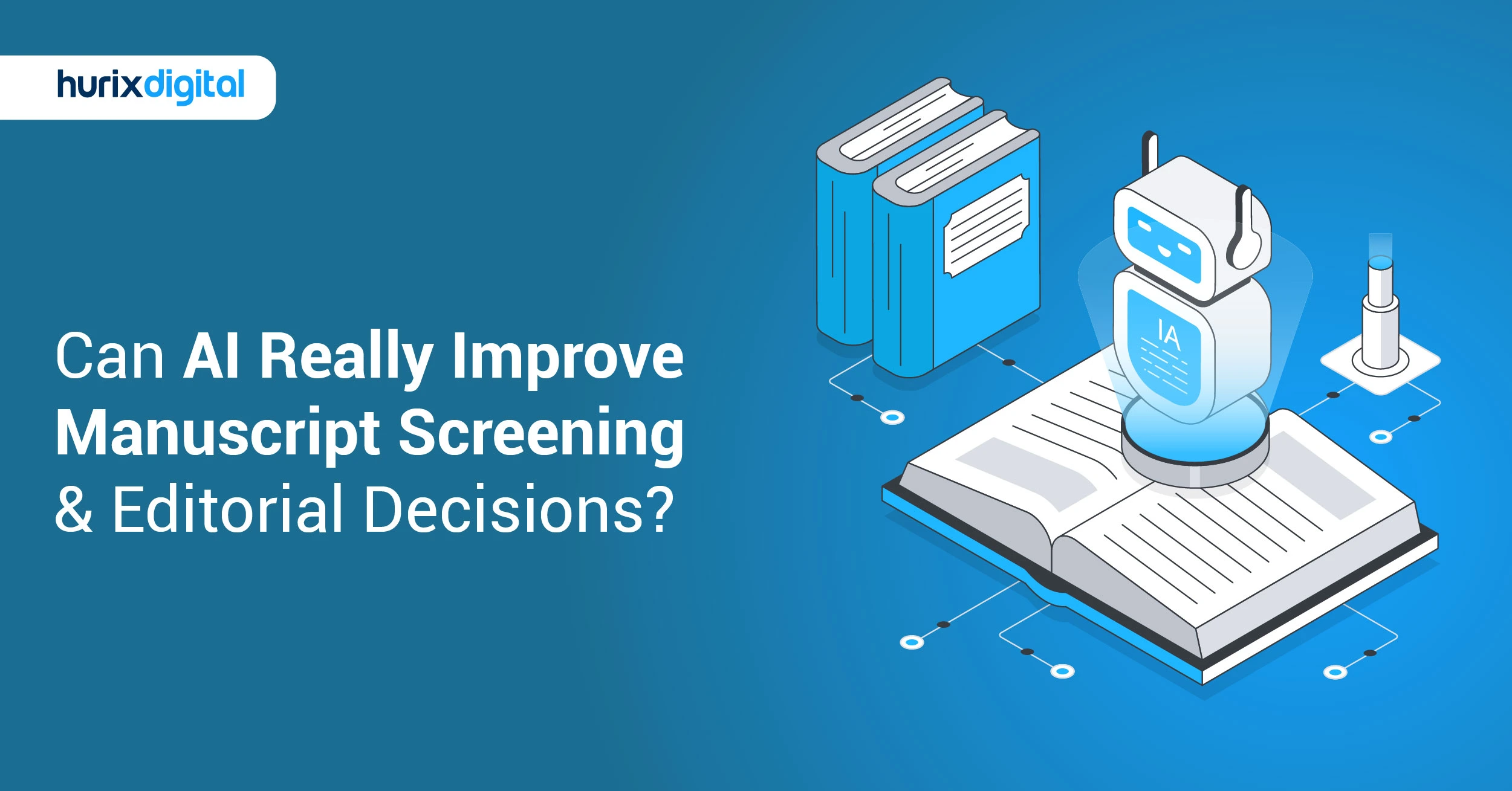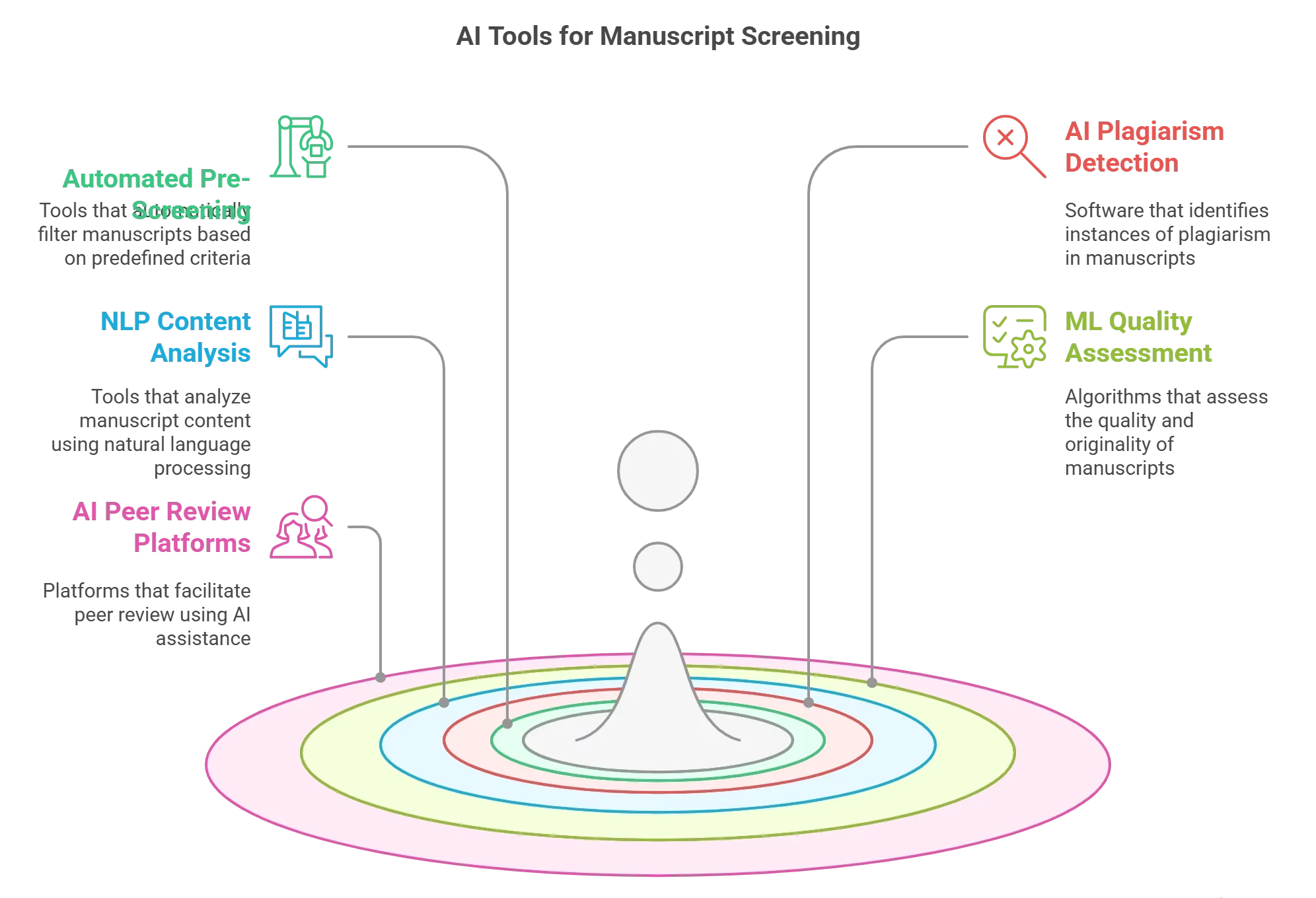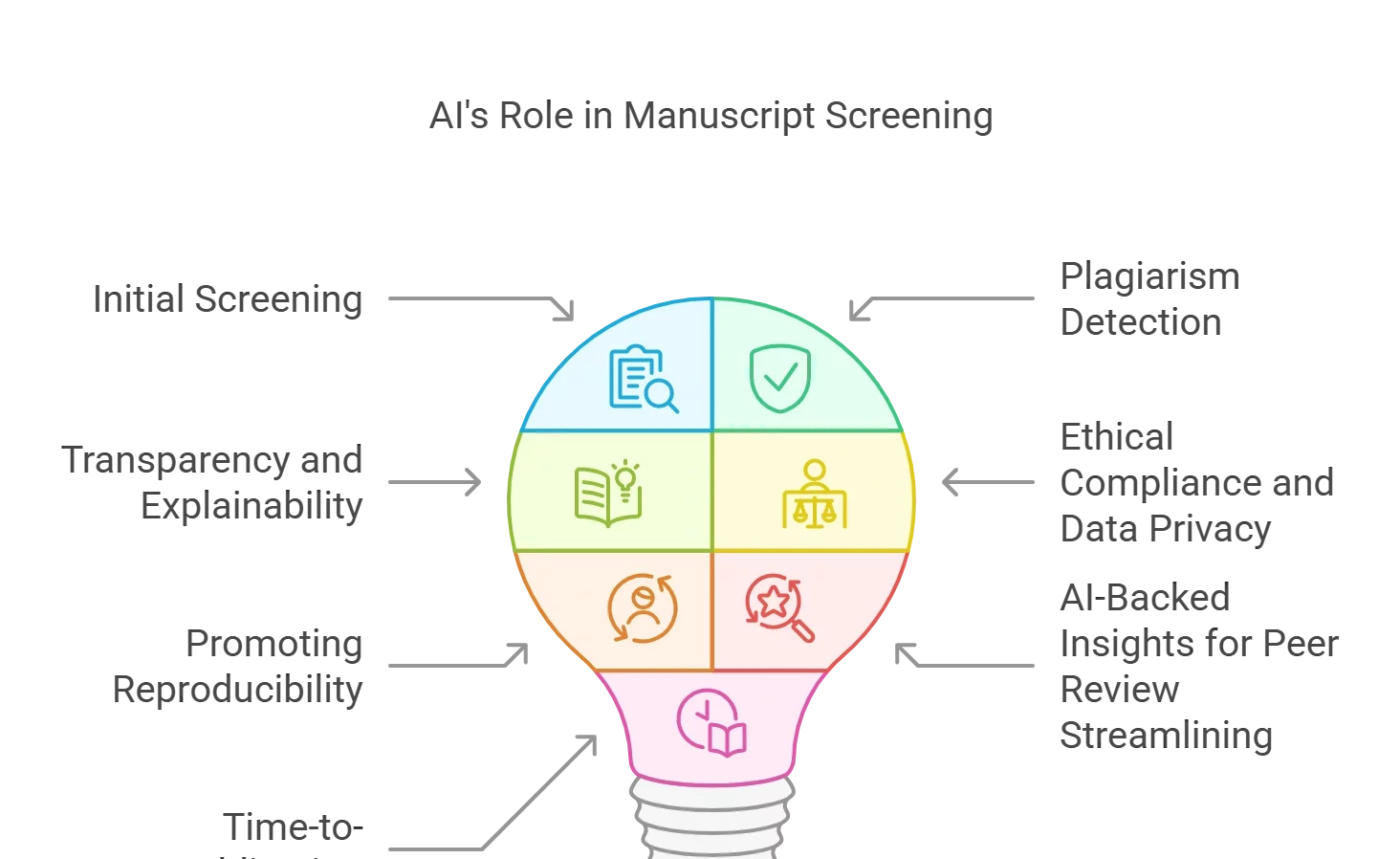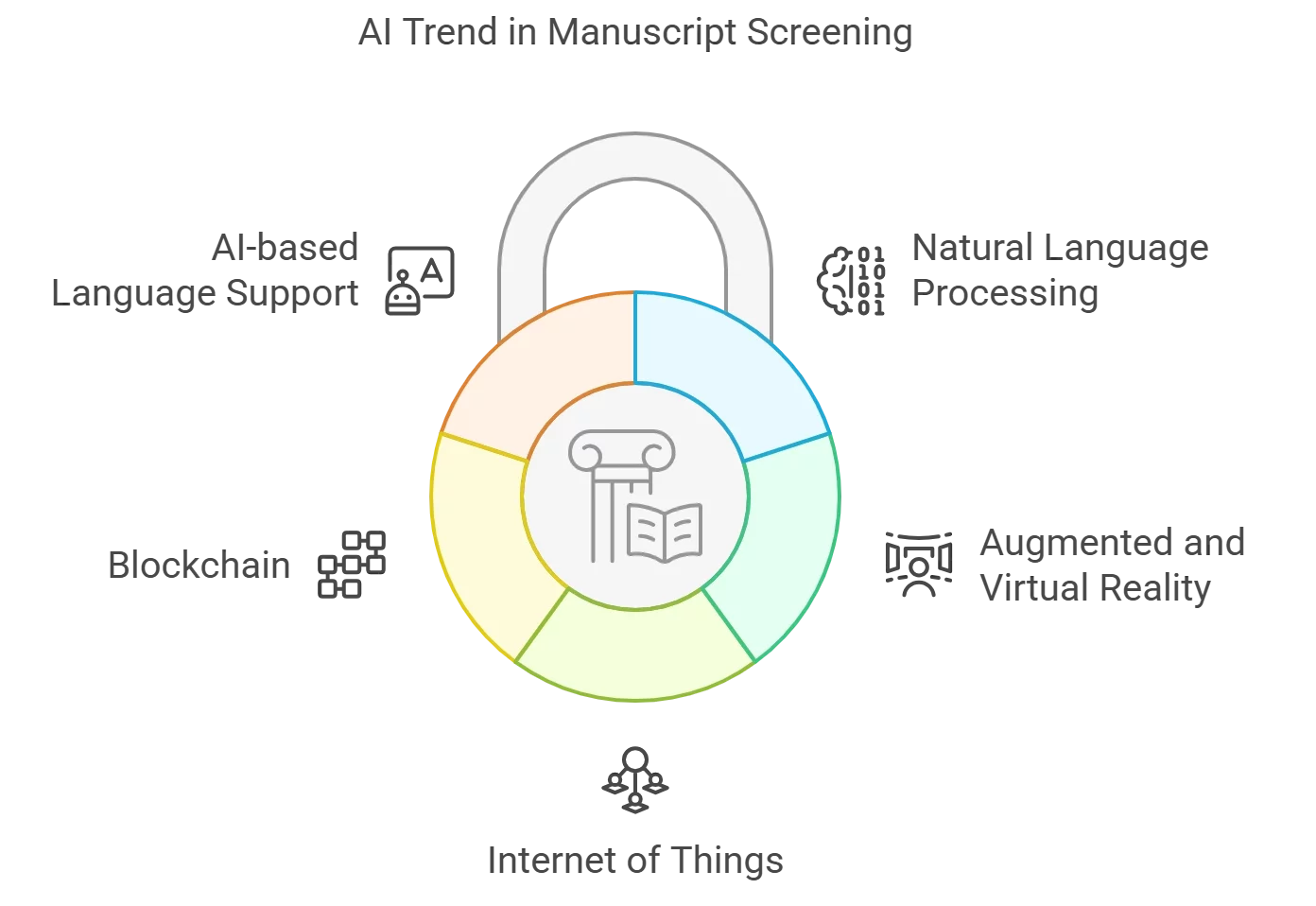
Can AI Really Improve Manuscript Screening & Editorial Decisions?
Summarize with:
Artificial Intelligence is transforming various sectors, such as publishing, particularly through its tools in manuscript screening and editing. In 2024, 83.2% of content marketers will rely on AI content generation tools to help drive their content marketing programs.
In modern publishing practices, three forms of AI writing—AI text prediction, AI text editors, and AI text generators—greatly influence manuscript screening and editorial practices.
AI is an excellent tool because it helps publishers analyze data quickly, identify trends, and enhance content. Such practices expedite manuscript evaluation and ensure that it is more accurate and transparent than ever. Being an editor requires embracing AI’s full potential while maintaining editorial integrity.
Let us read ahead about the significance and influence of AI-powered manuscript screening and editorial processes.
Table of Contents:
- About Modern Manuscript Screening and Editorial Practices
- Why is AI in Manuscript Checking Gaining Popularity?
- AI in Manuscript Checking: Is it Truly Beneficial?
- Types of AI-Powered Tools for Manuscript Screening
- Impact of AI on Manuscript Screening and Editorial Practices
- Top AI Trends for Manuscript Screening and Editorial Practices
- Conclusion
About Modern Manuscript Screening and Editorial Practices
Manuscript assessment has undergone major changes with the growth of submissions, various diverse topics of research, and the demand for stricter evaluation standards. With the explosion of global research output, editorship has a huge challenge— maintaining proper quality and consistency within manuscripts while keeping up with the fast pace observed in publishing demands.
This is where Artificial Intelligence comes in as the transformative force. Leaning on advancements in machine learning and natural language processing, AI tools can now assist at almost every step of the editorial process. AI promises to streamline editorial workflows while maintaining high standards of quality and integrity.

Why is AI in Manuscript Checking Gaining Popularity?
The growing reliance on AI-powered tools for manuscript checking can be attributed to a few key reasons:
1. Increased Demand for Speed and Efficiency
Editors today face tight deadlines and high volumes of submissions. AI helps streamline manuscript proofreading by automating repetitive checks and flagging errors quickly. Consequently, editors can handle more reviews in less time while maintaining high standards without sacrificing speed.
2. Enhanced Consistency in Quality
AI in manuscript checking provides a consistent level of accuracy that minimizes the risk of overlooked errors. It standardizes processes like manuscript language editing to ensure that all content meets the same editorial quality, even when dealing with multiple manuscripts and diverse author backgrounds.
3. Cost-Effectiveness for Publishers
AI is cost-effective, especially compared to traditional manuscript proofreading services. Moreover, AI-powered solutions automate substantial parts of the review and reduce dependency on human resources.
Money saved means it can be allocated in other places, for example, to expand the publishing initiatives.
4. Growing Trust in AI’s Analytical Capabilities
We cannot ignore the fact that AI technology has become more sophisticated. Therefore, its capabilities in tasks like manuscript editing services have also grown. Publishers and editors are increasingly confident in AI’s ability to understand context, recognize stylistic nuances, adapt to varying editorial guidelines, etc.
All these reasons have contributed to making AI an invaluable tool for ensuring polished and impactful manuscripts.
AI in Manuscript Checking: Is it Truly Beneficial?
AI in education, AI in healthcare, AI in publishing—a lot is going on with AI. It seems like AI is the tool that fits everywhere, but can it really work effectively in every field?
When it comes to AI in manuscript checking, the advantages are certainly compelling. Faster turnaround times mean editors can process more manuscripts in less time and handle high submission volumes. AI also offers consistent quality, catching errors and enforcing standards without the fatigue or variability of human proofreading.
Still not convinced?
AI excels at identifying complex linguistic issues that are often missed in traditional proofreading. Here’s what it includes:
- Spotting inconsistent terminology or phrasing across a manuscript.
- Addressing redundancy and verbosity, pinpointing repetitive words or phrases that can weaken the impact of the content.
- Detecting awkward syntax and sentence structure and recommending corrections for convoluted sentence constructions.
- Identifying subtle errors in tone and style to maintain a professional tone throughout the manuscript.

Types of AI-Powered Tools for Manuscript Screening
Here are some key types of AI-powered tools that come in really handy for manuscript screening:
1. Automated Pre-screening Tools
These tools perform initial checks on manuscripts to confirm they meet basic criteria such as formatting guidelines, word count limits, and referencing styles. Automating these routine checks frees up human reviewers to focus on more substantive aspects of the manuscript.
Examples: Paperpal Preflight, Enago Read
2. AI-Powered Plagiarism Detection Software
Conventional plagiarism detection software typically uses text comparison methods for identifying copied content; however, AI-driven tools take a step further by examining the context and organization of text to detect complex forms of plagiarism, like rephrasing and content appropriation.
Examples: Turnitin, iThenticate, Dictera
3. Natural Language Processing (NLP) Tools for Content Analysis
NLP tools analyze the language of a manuscript to assess its clarity, conciseness, and readability. They also identify key themes, concepts, and arguments, helping editors quickly grasp the essence of the manuscript.
Examples: Grammarly, QuillBot
4. Machine Learning (ML) Algorithms for Quality Assessment
ML algorithms can be trained on large published article datasets to learn patterns and features associated with high-quality research. These algorithms then predict the likelihood of a manuscript being accepted for publication based on its content, novelty, and relevance.
Example: Dimensions Research Integrity
5. AI-Assisted Peer Review Platforms
These platforms integrate AI tools to streamline the peer review process. They can automatically match manuscripts with suitable reviewers, provide reviewers with relevant information and resources, and even offer feedback on the quality of their reviews.
Example: Clarivate Publons

Impact of AI on Manuscript Screening and Editorial Practices
Here are significant ways through which AI is shaping the future of manuscript screening and editorial practices:
1. Initial Screening
Manuscript screening platforms based on AI can scan for the manuscripts’ compliance with simple requirements. These can be elements like complying with word count, formatting, and the relevance of the topic of interest. AI can automatically highlight manuscripts that do not meet the basic requirements, thus aiding editors in effectively working on high-potential submissions.
2. Plagiarism Detection
AI plagiarism detectors have revolutionized the screening game. They can now detect identical content in vast segments of texts. AI software can find similar content across millions of publications. AI allows editors to promptly address ethical problems while upholding the authenticity of published work.
3. Transparency and Explainability
Research must be transparent, even as AI tools are integrated into the process. The author has to maintain a record of the specifications used in AI algorithms. According to the CONSORT-AI guidelines, authors must be transparent about AI tools used during data analysis or content generation, enabling other scientists to reproduce the findings. This level of transparency breeds trust and maintains the integrity of scientific publishing.
4. Ethical Compliance and Data Privacy
AI-assisted tools support ethical compliance and data privacy by strictly implementing ethical standards. AI helps check for sensitive information within the manuscript and even assists in anonymizing personal data when it is to be presented to the journal. Ethical compliance will give credence to the manuscript and allow it to open itself to global data protection standards.
5. Promoting Reproducibility
AI promotes open access, making reproducibility easier. Authors and publishers can make their data public for validation purposes. They can use AI tools to organize and share data within the AI framework, and manuscripts can develop the standard demands of reproducibility. This will raise the value of publishing work in a journal.
6. AI-Backed Insights for Peer Review Streamlining
The peer review process has proved to be of tremendous value, using AI as a preliminary insight and proposal. For instance, AI quickly frames preliminary manuscript assessments, indicating areas needing improvement. Editors noted that AI is useful as an add-on support that can help them produce an insightful review process.
7. Time-to-Publication
One of the most tangible benefits of AI is the reduction in time-to-publication. The traditional manuscript assessment process is time-consuming, often generating a bottleneck at the editorial level. AI tools can reduce weeks off this process with streamlined labor-intensive checks-from formatting to grammar correction.
According to research, manuscripts that utilized AI-powered tools for screening reduced their average review time and became more responsive to both their authors and readers.

Top AI Trends for Manuscript Screening and Editorial Practices
The following are some of the major trends and cutting-edge technologies driving impactful changes in manuscript screening and editorial processes:
1. Natural Language Processing and Large Language Models
NLP and LLMs are AI tools that transform the way editorial tasks are performed. These technologies help process large volumes of text. When used for certain types of manuscripts, the technology can assist editors in deciding whether the manuscript is clear or ambiguous, of quality or below standard, and relevant or irrelevant. The global growth for natural language is expected to reach approximately USD 48.46 billion by 2026.
NLP models can summarize content, identify inconsistencies, and even suggest edits, saving ample time in the initial screening and editing phases. They are increasingly being applied in the manuscript assessment process, where they help figure out gaps in the logic behind the document, biased usage of the language, and structural issues.
2. AR and VR
AR and VR are advanced AI tools for reviewing intricate, data-rich papers. AR/VR would be beneficial in explaining 3D models, complex datasets, or simulations presented in the manuscripts, leading to a much more exhaustive review of the research.
3. Internet of Things (IoT)
IoT-enabled devices, widely used in research for data collection, are increasingly becoming a part of the publishing lifecycle. For manuscripts involving real-time data from IoT, publishers can even use IoT verification AI tools to verify data and ensure that it reflects facts.
4. Blockchain for Transparent Manuscript Review and Data Integrity
From the applications of blockchain technology, it is possible to build an editorial process that offers transparency and traceability. Using blockchain would allow for accuracy checks in manuscript reviews, identification of data manipulation, and blocking fraudulent changes.
5. AI-based Language and Grammar Support
Since most cross-border publishing involves authors whose first language is not English, AI language editing tools facilitate the elimination of vagueness from a manuscript before it is sent up to the editorial board. AI-powered tools help authors and editors refine their language for publication standards. These AI tools identify problems of syntax, tone, and jargon, giving editors and authors opportunities for a more global market.
Conclusion
Utilizing AI tools in the manuscript screening process facilitates decision-making, enhances consistency, and upholds rigorous quality standards. By minimizing the editorial burden and enabling more concentrated oversight, AI contributes to the caliber of accepted articles while aiding the professional development of editorial staff.
Adopting this technology places you at the top of contemporary publishing, prepared to address the challenges of an expanding and changing industry. As AI technology evolves, we can expect even more sophisticated and powerful tools to emerge, further transforming academic publishing.
If you want an AI-backed, comprehensive solution for your publishing needs, Hurix Digital is the answer. This tool helps you overcome challenges like writer’s block, improve decision accuracy, and ensure quality in your editorial process.
Connect with us today and discover how AI-powered solutions radically alter your manuscript screening process!
Summarize with:

Vice President – Content Transformation at HurixDigital, based in Chennai. With nearly 20 years in digital content, he leads large-scale transformation and accessibility initiatives. A frequent presenter (e.g., London Book Fair 2025), Gokulnath drives AI-powered publishing solutions and inclusive content strategies for global clients
 A Space for Thoughtful
A Space for Thoughtful 



